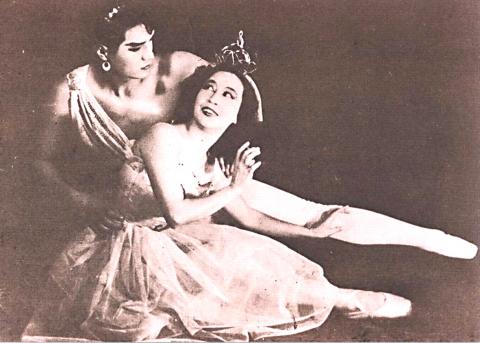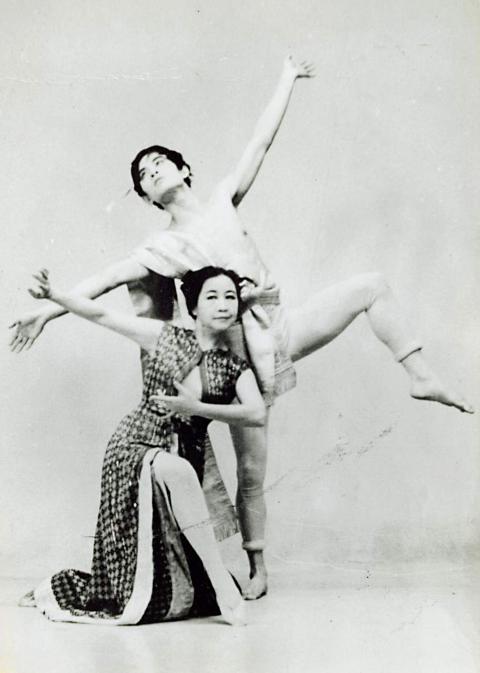May 29 to June 4
Tsai Jui-yueh (蔡瑞月) practiced her dance steps diligently on the deck of the ship taking her from Tokyo back to Taiwan. World War II had ended about a year previously, and Tsai gave up a chance for a personal recital in Tokyo to catch the last ride home.
“I didn’t care if other passengers thought I was crazy,” she says in Prophet of Taiwan Dance — An Oral History by Tsai Jui-Yueh (台灣舞蹈的先知 – 蔡瑞月口述史). “I couldn’t wait to get home to perform, to choreograph, to teach.”

Photo courtesy of the Tsai Jui-yueh Foundation
During high school, Tsai heard a Japanese person describe Taiwan as a “barren desert for dance.”
“I never turned down a show after I got back because I was determined to spread the seeds of dance all over Taiwan,” she says.
Little did she know that Taiwan would not be kind to her.

Photo courtesy of the Tsai Jui-yueh Foundation
INNOCENCE AND PASSION
A few years earlier, members of Tsai’s dance troupe were struggling to climb up a snow-covered slope in 30 degrees below zero temperatures in the Kuril Islands.
Tsai’s teacher Ishii Midori recalls, “Tsai suddenly took her shoes off and ran barefoot like a madwoman up the hill. I’ll never forget that scene.”
The introduction to Tsai’s book states that it was this “innocence and passion” that drove Tsai to defy societal expectations and become the pioneer of modern dance in Taiwan.
“Before the field of creative dance even existed in Taiwan, Tsai already knew that she wanted to study in Japan and catch up on the latest trends from the West,” Ishii says. “Back then, this was a groundbreaking decision.”
Growing up in Tainan in the 1920s, Tsai says she would find joy in moving her body rhythmically.
“I didn’t do it because someone taught me, or because there was music playing as record players were rare back then,” she recalls. “I had no idea that this was called ‘dancing.’”
There were few opportunities during that era, and Tsai’s favorite moment during elementary school was a weekly aerobic dance class that she excelled in. During high school, she risked punishment and attended dance performances by Japanese troupes whenever she could. Her first performance was during a school fair, where she drew resentment from her classmates for being able to carry out the most difficult moves with ease despite not being an official member of the dance club.
Western contemporary dance took root in Japan after Russian ballerina Anna Pavlova performed The Dying Swan there in 1922. After almost a year of persuasion, Tsai’s father finally allowed her to head to Japan.
“On the ship, I was summoned by the captain for questioning, as he found that it was unusual that someone would go to Japan to study dance,” she recalls. “He thought I had run away from home.”
World War II provided an opportunity for Tsai to see the world. She participated in several extended tours to entertain Japanese troops. She wasn’t scared going to all these combat zones, stating that she was too young to know the horrors of war and death — until a car accident landed her in the hospital in Yangon where she saw buckets of amputated limbs.
UNWELCOME AT HOME
Tsai turned down Ishii’s offer to organize a personal recital for her after the war and headed home.
She started teaching at her alma mater in Tainan and was also invited to perform around the country for the newly-arrived Chinese Nationalist Party (KMT) troops. Her popularity grew, completing many highly acclaimed performances in Taipei to great fanfare. She never turned down a show, performing tirelessly in theaters, schools, churches, factories, parks, beaches and more.
In June 1949, Tsai’s husband Lei Shih-yu (雷石榆), an Indonesian-born Chinese poet, law professor and newspaper publisher, was taken away by government troops and deported to China as the KMT’s White Terror rule intensified. The pair planned to reunite in Hong Kong, but it wasn’t until after Tsai’s “final performance” in Taiwan that she was informed she was not permitted to leave the country. Tsai refused to divorce Lei and continued to teach dancing. She was soon arrested, presumably for keeping in contact with Lei, and thrown in jail. The two would not see each other again until 1990.
The oral history book describes Tsai’s next performance as one of several events that demonstrated her mental toughness. She was preparing for a Mid-Autumn Festival performance with other prisoners when she heard that her father had died. Devastated, she still managed to put together the show in a month and played a character that had lost her son. She says she felt immense sorrow when the prisoners performed at Taipei’s Zhongshan Hall, as the shows there were once attended by her family and friends.
Tsai continued her dance activities with gusto after her release in 1953, but she still ran into problems as a former political prisoner. She was under surveillance, had to report her whereabouts and was denied several opportunities to perform abroad. Many local performances were also aborted for various reasons, including one that she prepared seven years for.
“One incident took place after another, and I wondered how much money the government spent each year just to make people’s lives difficult,” she says.
In 1983, she was permitted to leave. She headed for Australia to join her son but continued to be involved in Taiwan’s dance scene until her death on May 29, 2005.
“It was difficult to leave behind my beloved country and dance studio,” she says. “But I could finally be free of political persecution, which had sucked on my pride and soul like a leech.”
Taiwan in Time, a column about Taiwan’s history that is published every Sunday, spotlights important or interesting events around the nation that have anniversaries this week.

Most heroes are remembered for the battles they fought. Taiwan’s Black Bat Squadron is remembered for flying into Chinese airspace 838 times between 1953 and 1967, and for the 148 men whose sacrifice bought the intelligence that kept Taiwan secure. Two-thirds of the squadron died carrying out missions most people wouldn’t learn about for another 40 years. The squadron lost 15 aircraft and 148 crew members over those 14 years, making it the deadliest unit in Taiwan’s military history by casualty rate. They flew at night, often at low altitudes, straight into some of the most heavily defended airspace in Asia.

Many people in Taiwan first learned about universal basic income (UBI) — the idea that the government should provide regular, no-strings-attached payments to each citizen — in 2019. While seeking the Democratic nomination for the 2020 US presidential election, Andrew Yang, a politician of Taiwanese descent, said that, if elected, he’d institute a UBI of US$1,000 per month to “get the economic boot off of people’s throats, allowing them to lift their heads up, breathe, and get excited for the future.” His campaign petered out, but the concept of UBI hasn’t gone away. Throughout the industrialized world, there are fears that

Taiwan’s democracy is at risk. Be very alarmed. This is not a drill. The current constitutional crisis progressed slowly, then suddenly. Political tensions, partisan hostility and emotions are all running high right when cool heads and calm negotiation are most needed. Oxford defines brinkmanship as: “The art or practice of pursuing a dangerous policy to the limits of safety before stopping, especially in politics.” It says the term comes from a quote from a 1956 Cold War interview with then-American Secretary of State John Foster Dulles, when he said: ‘The ability to get to the verge without getting into the war is

Like much in the world today, theater has experienced major disruptions over the six years since COVID-19. The pandemic, the war in Ukraine and social media have created a new normal of geopolitical and information uncertainty, and the performing arts are not immune to these effects. “Ten years ago people wanted to come to the theater to engage with important issues, but now the Internet allows them to engage with those issues powerfully and immediately,” said Faith Tan, programming director of the Esplanade in Singapore, speaking last week in Japan. “One reaction to unpredictability has been a renewed emphasis on